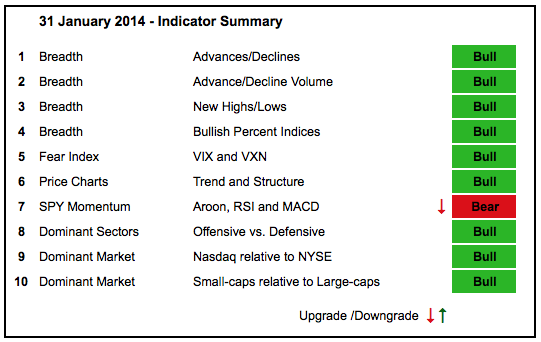Stocks were hit with more selling pressure and the major index ETFs are now down year-to-date. This was enough to push the momentum indicators into negative territory and prompt a downgrade. This pullback, however, could be just a correction. Interestingly, large-caps led this decline and small-caps are holding up well. Also note that QQQ is down just 1.66% year-to-date and techs are holding up well. Of note, Net New Highs for the NYSE and Nasdaq dipped to levels that previously signaled the end of corrections. The long-term trends are still up for the major index ETFs, AD Lines and AD Volume Lines. This means pullbacks are treated as corrections and higher lows are expected to form.
Programming note: I must discontinue the indicator summary, intermarket charts and breadth charts. Today will be the last day for these features on Art's Charts. The commentary for this indicator summary will be folded into the Market Message, which I write on Fridays. The charts will eventually continue in a staff section for the public chartlists. Sorry for any inconvenience.
- AD Lines: Bullish. The Nasdaq and NYSE AD Lines fell back, but not before hitting new highs in January. They remain in uptrends overall.
- AD Volume Lines: Bullish. The Nasdaq and NYSE AD Volume Lines also fell back, but not before hitting new highs in January.
- Net New Highs: Bullish. Net New Highs for the NYSE fell into negative territory and Net New Highs for the Nasdaq slipped below +2%. Prior dips end before these indicators move below -2%.
- Bullish Percent Indices: Bullish. Eight of the nine sector BPIs are above 50%. The Energy BPI ($BPENER) fell to 40.91%.
- VIX/VXN: Bullish. The S&P 500 Volatility Index ($VIX) and Nasdaq 100 Volatility Index ($VXN) bounced off the low end of their six month ranges and are now in the middle of this range. Volatility is still not excessively high.
- Trend-Structure: Bullish. The major index ETFs pulled back sharply the last few weeks, but not before SPY, IWM, QQQ and MDY recorded new highs earlier this month.
- SPY Momentum: Bearish. RSI broke below 40 and MACD(5,35,5) moved into negative territory. The Aroon Oscillator is still above -50, but hit -45 and it would not take much to push it below -50.
- Offensive Sector Performance: Bullish. XLY is lagging and broke below the December low. XLF and XLK got this hard the last two weeks, but did hit new highs earlier this month. XLI is lagging a bit because it did not hit a new high this month. In short, all four hit new highs within the last six weeks and remain in long-term uptrends.
- Nasdaq Performance: Bullish. The $COMPQ:$NYA ratio hit a new high this month as the Nasdaq continues to outperform the NY Composite.
- Small-cap Performance: Bullish. The $RUT:$OEX ratio is near its September high and small-caps are outperforming large-caps.
- Breadth charts (here) and intermarket charts (here) have been updated.
This commentary and charts-of-interest are designed to stimulate thinking. This analysis is
not a recommendation to buy, sell, hold or sell short any security (stock ETF or otherwise).
We all need to think for ourselves when it comes to trading our own accounts. First, it is
the only way to really learn. Second, we are the only ones responsible for our decisions.
Think of these charts as food for further analysis. Before making a trade, it is important
to have a plan. Plan the trade and trade the plan. Among other things, this includes setting
a trigger level, a target area and a stop-loss level. It is also important to plan for three
possible price movements: advance, decline or sideways. Have a plan for all three scenarios
BEFORE making the trade. Consider possible holding times. And finally, look at overall market
conditions and sector/industry performance.







